ISSN 2348-1196 (print)
International Journal of Computer Science and Information Technology Research ISSN 2348-120X (online) Vol. 9, Issue 1, pp: (10-18), Month: January - March 2021, Available at: www.researchpublish.com

ISSN 2348-1196 (print)
International Journal of Computer Science and Information Technology Research ISSN 2348-120X (online) Vol. 9, Issue 1, pp: (10-18), Month: January - March 2021, Available at: www.researchpublish.com
Waleed Asender1 , Muhsin Mustafa Hassan2, Mohd Adam Suhaimi3
1,2,3 Kulliyyah of Information and Communication Technology 1,2,3 International Islamic University of Malaysia, Kuala Lumpur, Malaysia
Authors Emails: 1walidov@gmail.com, 2mohsn.mustafa@gmail.com, 3adam@iium.edu.my
Abstract: E-Government is the application of ICT in government operations, achieving public ends by digital means, the main objective is to utilize the ICTs to deliver government services to citizens and businesses more effectively and efficiently. The Jordanian government's efforts towards e‐governance are commendable, however, there are certain impediments that caused a significant regression in the E-Government Development Index rank for Jordan in the past decade. The purpose of this paper is to assess the efforts made by Jordan in the direction of e‐governance in the past two decades, the main obstacles faced by these efforts, the real reasons behind the significant regression of the EGDI rank in the past 10 years, and finally give recommendations to address these challenges and succeed in the process of E-government implementation in Jordan. E-Government Development Index (EGDI) is a global rank published by the UN since 2003 that presents the state of e-government development in 193 countries, it combines a set of indicators that evaluates the level of e-governance implementation in the specific country. Jordan ranked 117 in 2020 with a score of 0.5309 increasing 66 ranks from 51 in 2010. The EGDI has three important dimensions taken into consideration in the process of measurement: Provision of Online Services, Telecommunication Infrastructure and Human Capacity. This paper will study the current situation in Jordan within these dimensions to discover the short comes and offer recommendations towards solving this problem.
Keywords: E-government, Jordan, E-transformation, ICT, EGDI, Challenges, Readiness, OSI, TII, HCI.
In the era of digital, it became vital to provide governmental services online to citizens. E-government is the use of information and communications technologies (ICTs), such as mobiles, computers and the Internet, to provide public services to citizens and other persons in a country or region [1]. An efficient e-government will ease the daily interaction between the government and the citizens (G2C) resulting in significant saving of time and resources, increase the quality of governmental service, increases trust in the government by giving accessibility to crucial official information needed by the citizens, empower people to get involved in the process of decision-making, increase transparency and traceability of transactions and bridge the digital divide.
Since its inception in 2001, the United Nations E-Government Survey (UNEGS) has become an indispensable “ranking, mapping and measuring” tool for policymakers and analysts engaged in comparative analysis and contemporary research on e-government. This survey has introduced the E-Government Development Index (EGDI). It is a comparative ranking of 193 countries of the world which assesses e-government development at the national level according to three primary indicators: i) the Online Service Index (OSI) that measures the online presence of the government in terms of service delivery; ii) the Telecommunication Infrastructure Index (TII); iii) Human Capital Index (HCI). Constructing a model for the measurement of digitized services, the Survey assesses the 193 member states of the UN according to a quantitative composite index of e-government readiness based on website assessment: telecommunication infrastructure and human resource endowment [2]. Another indicator to evaluate a country’s e-government implementation level is the EParticipation Index (EPI), this metric is also provided by UN’s E-government survey, it extends the dimension of the Survey by focusing on the use of online services to facilitate provision of information by governments to citizens (“einformation sharing”), interaction with stakeholders (“e-consultation”), and engagement in decision-making processes
ISSN 2348-1196 (print)
International Journal of Computer Science and Information Technology Research ISSN 2348-120X (online) Vol. 9, Issue 1, pp: (10-18), Month: January - March 2021, Available at: www.researchpublish.com
(“e-decision making”) [3]. These indexes put standards and clear outlines for participating countries to follow in the process of implementing e-government, putting the right strategies to achieve this goal is much easier than before, this is also working in parallel with the UN Sustainable Development Goals (SDGs) agenda.
In the journey of applying e-government project, the country’s policy makers and strategy implementers would definitely face obstacles and challenges, as many external factors are impacting this process, such as possessing a solid and advanced ICT infrastructure, which is considered as mega project for any country that requires huge resources and time, man power with mandatory skills to provide the e-government service to the public will consumes time and resources in training and preparation, the most important yet uncontrolled factor is the level of citizens participation, which needs an education and awareness about these e-services and how to use it. In this research we aim to address such challenges faced by the Jordanian government in their 20 years journey of the implementation of e-government, study the ups and downs and analyse all reasons behind the unsatisfying level of e-transformation despite the long period and high efforts, and finally discuss the results to contribute an applicable recommendation that could be carried out or further studied.
The e-government field has emerged globally in late 1990’s, it has been showing ever since a significant positive socioeconomic implications to whomever apply it efficiently and effectively [4], Jordan was among the first to carry out the application of e-government, it was launched by His Majesty King Abdullah II in 2001, which aims to drive the nation’s transformation into a knowledge society. Jordan’s efforts towards implementing e-government went through two major phases; The initial strategy roadmap (2003-2006) that resulted in establishing the Secure Government Network (SGN) which provides connectivity, internet and email services to 18 government entities, and launching the National Portal which is a “one stop shop” for user interaction with all Government of Jordan entities [5]. The second phase was the National e-Government Strategy and Roadmap (2006-2009) which resulted much more achievements depending on the previous phase accomplishments such as establishing the E-government National Steering Committee with representatives in 107 government entities, expanding the SGN connecting total of 84 government entities, launch of SMS Gateway that supports 77 government entities, launch of Jordanian Payment Gateway to which 13 government transactional e-services are integrated and development and launch of over 90 vertical e-services that are currently posted on the E-government Portal (URL: http://www.jordan.gov.jo) [5].
The Jordanian government continued investing heavily in E-government initiatives for the last 10 years to transform from traditional service delivery to more effective and efficient service to deliver high-quality customer-centric and performance-driven services to E-government stakeholders (Majdalawi et al., 2015), however, the ranking of Jordan in EGDI has dropped 66 ranks from 51 in the year 2010 to 117 in the year 2020, this significant regression in ranking regardless of the tremendous endeavours to accomplish high level of e-transform worth studying and investigating to stand over the gaps and flaws in the strategy of E-government implementation, the Fig. 1 shows the rapid drop in Jordan ranking in EGDI in past decade.
Fig. 1: Jordan EGDI ranking
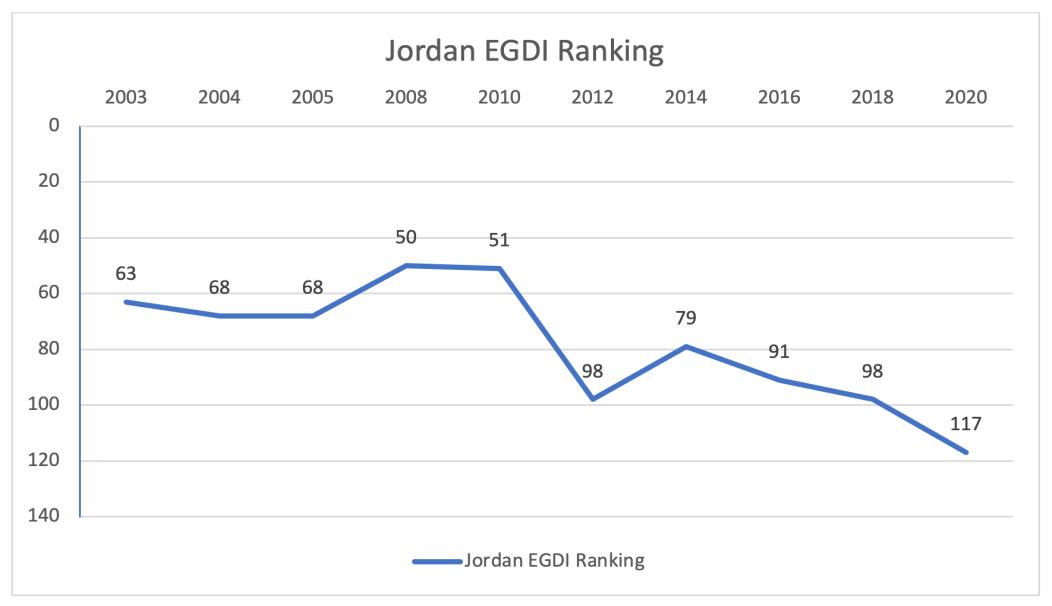
ISSN 2348-1196 (print)
International Journal of Computer Science and Information Technology Research ISSN 2348-120X (online) Vol. 9, Issue 1, pp: (10-18), Month: January - March 2021, Available at: www.researchpublish.com
To better understand the ranking of Jordan and the reasons of this fluctuation in rankings throughout the past two decades, we should look at the three indicators that decide this ranking, as a developing country it was expected to have low TII, but Jordan has shown an impressive improvement in this criteria, on the other hand, the in HCI Jordan was performing very well but it started to decline slightly in the last decade, and finally the biggest issue for Jordan appears in OSI metric which wasn’t going well and still struggling below both world and region average. Fig. 2 shows the performance of Jordan in all three indicators through the past two decades.
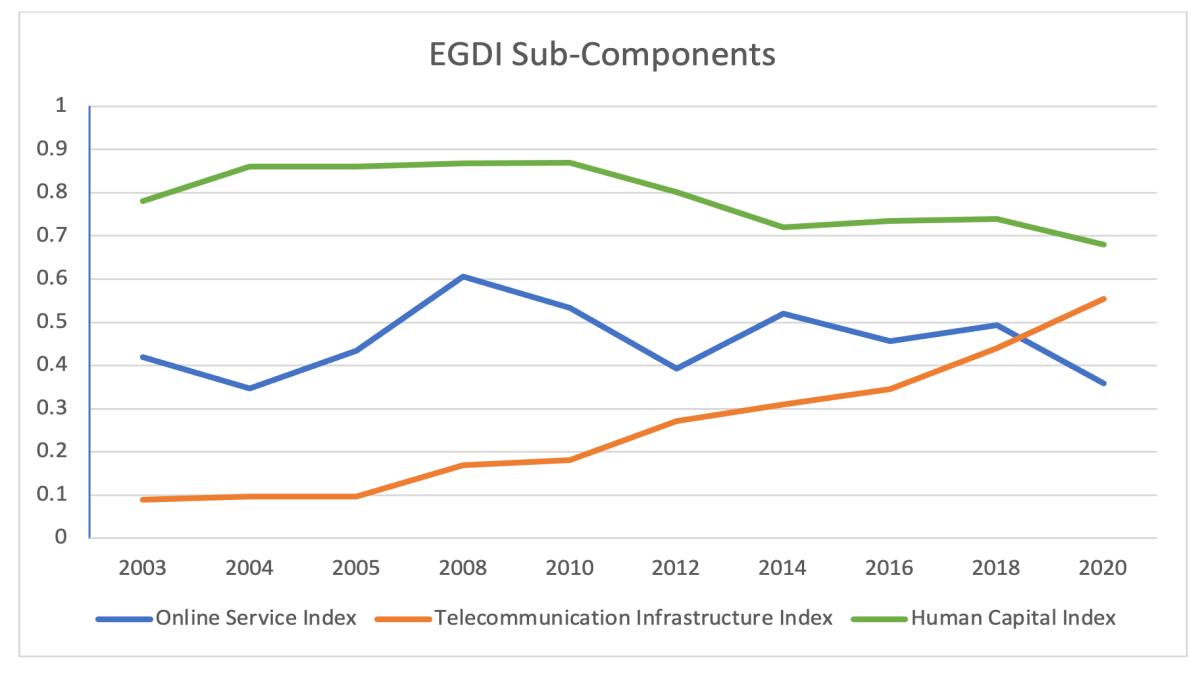
In order to have a solid strategy towards accomplishing any achievement; a plan should include three main ingredients; objectives, stakeholders and a work plan. In implementing E-government in Jordan, which is usually referred to as Etransformation movement, these three parameters were set clearly in the new strategy for the years 2014 to 2016. Firstly, four stakeholders were specified: i) Citizens (C), ii) Businesses (B), iii) Government Entities (G) and iv) Government Employees (E). Secondly, four strategic objectives were put as the mission; i) G2C and G2B Accessibility, ii) G2G and G2E Information sharing, iii) Infrastructure Connectivity and iv) Policy and Standard Reforming. After having these two main elements set it was easy to put a work plan that will engage the stakeholders, so four initiatives were launched to carry out this plan; i) Whole of Government, ii) e-Participation, iii) m-Government and iv) Open Data. These initiatives made a lot of achievements that worked collaboratively towards the final goal, however, to keep these efforts stimulated, three projects were launched to monitor and supervise the overall government e-transformation endeavours; i) eTransformation Award, ii) “Daleel” Consultation Service and iii) “MADA” Measuring Progress. Fig. 3 shows this strategy in detail.
The four initiatives of e-transformation are evolving around the maturity of service delivery; emerging, enhanced, transactional and connected, the government of Jordan is aiming to achieve the transactional stage by end of this Strategy term, while currently it is in the late enhanced stage, where citizens and businesses have access to about 85 e-Services, four of which are transactional and three of those services offer online payment through the Jordan Payment Gateway (JoPAY) [5].
Jordanian e-government program has four pillars; technology infrastructure, business level, institutional framework and legal regulations. The core base of these pillars is the leadership vision of e-government as a tool to develop the public sector, and above these pillars are e-services (Khasawneh et al., 2011). We can relate EGDI dimensions to these four pillars in a try to evaluate the readiness of Jordan to implement the E-government concept.
ISSN 2348-1196 (print)
International Journal of Computer Science and Information Technology Research ISSN 2348-120X (online) Vol. 9, Issue 1, pp: (10-18), Month: January - March 2021, Available at: www.researchpublish.com
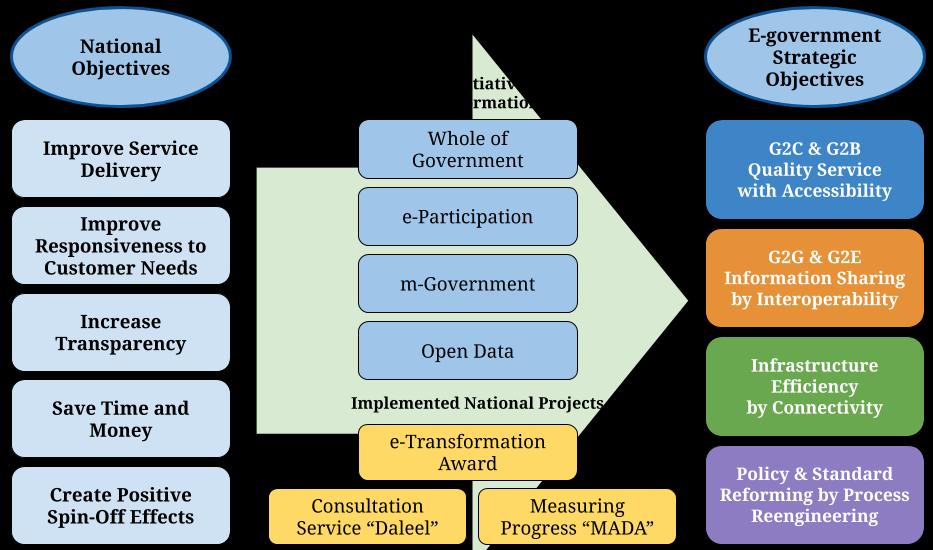
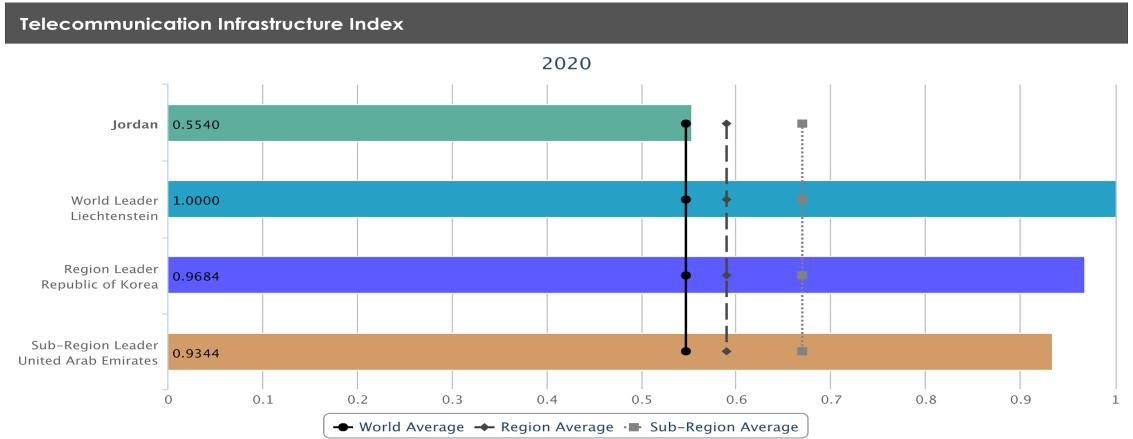
The Telecommunication Infrastructure Index is an arithmetic average composite of four indicators: i) Estimated internet users per 100 inhabitants; ii) Number of mobile subscribers per 100 inhabitants; iii) Active mobile-broadband subscription; and iv) Number of fixed broadband subscriptions per 100 inhabitants. Fig. 4 shows that Jordan is performing slightly better than the world average with a score of 0.554, which is a good accomplishment and any efforts toward this goal should be maintained, but still need for slight improvement as the ranking is very close to the lower average.
To better understand the factors of this score, we researched the performance of Jordan within these TII indicators for the past five years, shown in TABLE I.
TII Indicator 2015 2016 2017 2018 2019
Estimated internet users per 100 inhabitants 60.1 62.3 66.8 66.8 66.8
Mobile subscribers per 100 inhabitants 148.9 102.8 99.2 87.6 77
Active mobile broadband subscription 16.1 19.1 N/A N/A N/A
Fixed broadband subscriptions per 100 inhabitants 3.34 3.15 3.41 3.93 4.65
ISSN 2348-1196 (print)
International Journal of Computer Science and Information Technology Research ISSN 2348-120X (online) Vol. 9, Issue 1, pp: (10-18), Month: January - March 2021, Available at: www.researchpublish.com
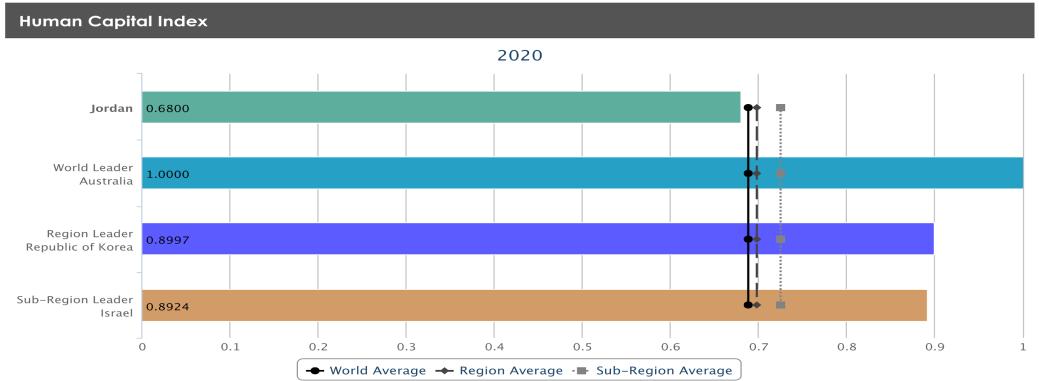
The Human Capital Index (HCI) consists of four components: i) Adult literacy rate; ii) The combined primary, secondary and tertiary gross enrolment ratio; iii) Expected years of schooling; and iv) Average years of schooling. The level of literacy is an indicator for the readiness of people to adopt the e-government, having an efficient infrastructure is not enough if the people are not educated to use it, many e-services are already existing but very few of people are using it and still depending on the old traditional governmental transactions and procedures.
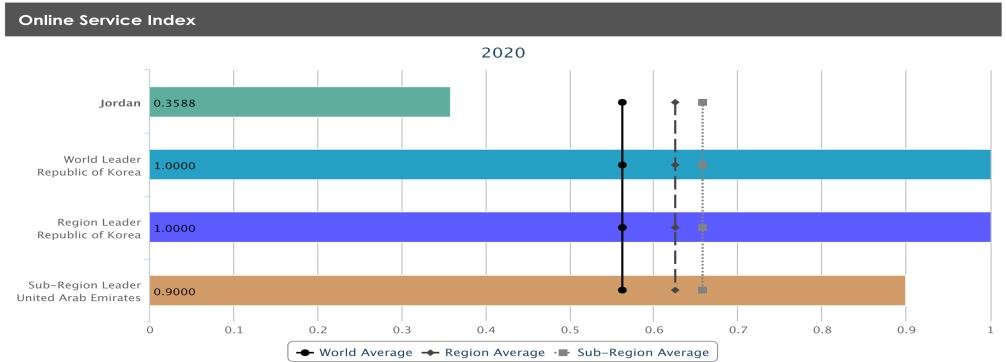
To better understand the factors of this score, we researched the performance of Jordan within these HCI indicators for the past five years, shown in TABLE II, which shows good performance and steady improvement.
HCI Indicator 2014 2015 2016 2017 2018
Adult literacy rate 97.8 97.9 98 98.1 98.2 Combined primary, secondary and tertiary gross enrolment ratio 60.9 59.7 58.2 59.7 61.6
Expected years of schooling 11.9 11.7 11.4 11.4 11.4
Average years of schooling 10.3 10.4 10.4 10.5 10.5
Online Service indicator is based on the assessment of the country's E-government Portal website in the native language, as well as the websites of the related ministries and departments. To evaluate this assessment an Online Services Questionnaire (OSQ) consisting of a list of 148 questions is held. Each question calls for a binary response. Every positive answer generates a “more in-depth question” inside and across the patterns [5]. Fig. 6 shows an alarming level of online services, with a score of just 0.3588 which is way below the world average, it became obvious that it's the main problem of the low EGDI ranking. In this paper the Jordanian e-government portal was examined according to three aspects; i) Technical, ii) Informational and iii) Services Integration, to determine the roots of the current score.
Fig. 6: Online Service Index of Jordan
ISSN 2348-1196 (print)
International Journal of Computer Science and Information Technology Research ISSN 2348-120X (online) Vol. 9, Issue 1, pp: (10-18), Month: January - March 2021, Available at: www.researchpublish.com
The essence of a high quality website can be broken down into four characteristics, i) Responsiveness, ii) Speed, iii) Quality Search Engine Optimization (SEO) and iv) Great User Experience (UX) [22].
According to stats surrounding mobile traffic vs desktop traffic in 2020, most internet traffic comes from mobile –50.48%. 46.51% comes from desktop. Tablets currently have the least traffic, at only 3% (Petrov, 2020), a high quality website should be optimized to work on all devices.
After testing the Jordanian E-government portal, we found its adopting the responsiveness technology, however, it's not perfectly done and there is room for improvement.
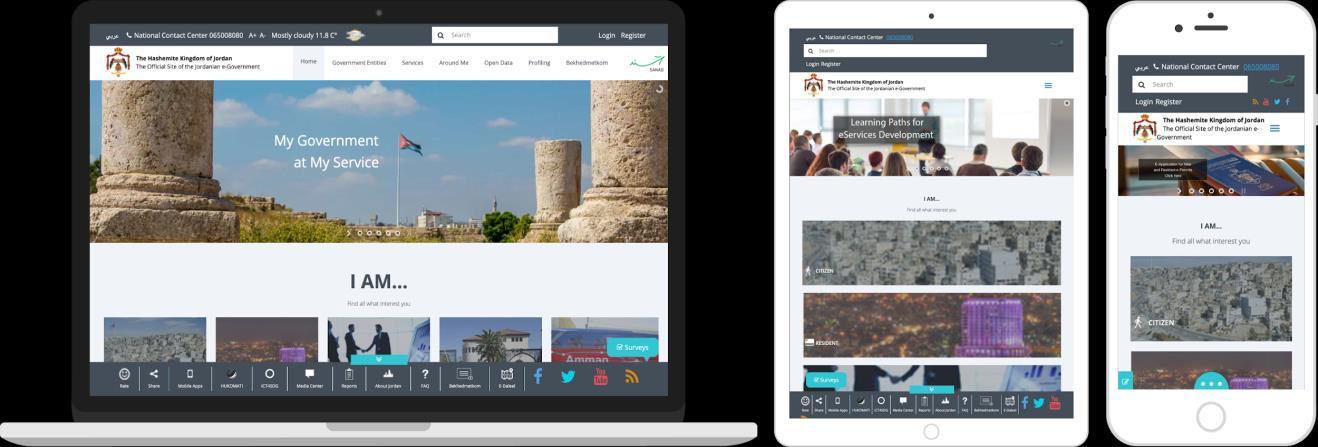
On average, if your website takes longer than 3 seconds to load, approximately 40% of your visits will abandon your site. We tested the site with Google’s Page Speed Analysis tool and returned a very poor result; 2/100 for mobile version and 23/100 for desktop version, which both are way below the acceptable average.
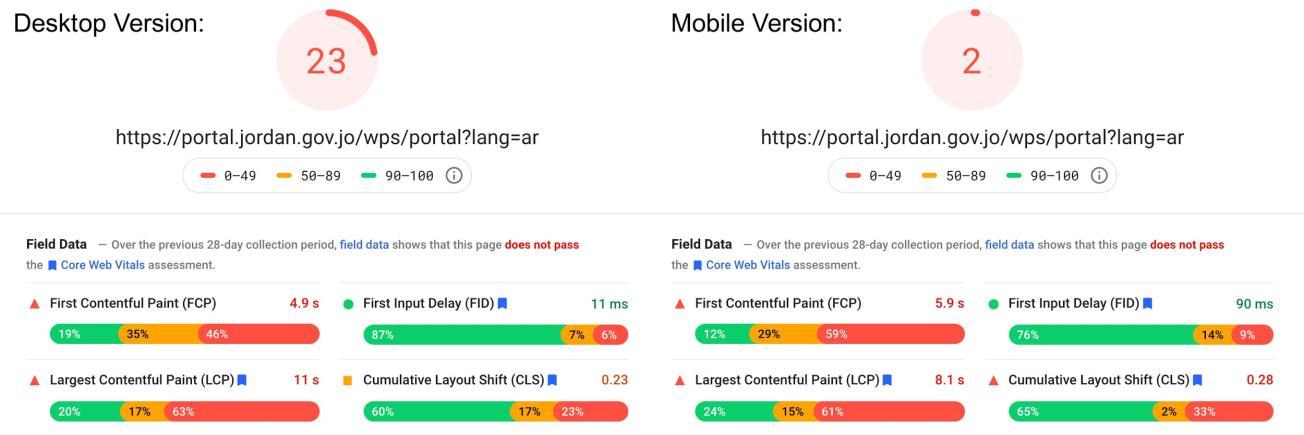
SEO are methods used to increase the visibility of the website on search engines, knowing that 80% of traffic comes from search engines, we realize the significant impact of having quality SEO for the website to gain traffic. For Jordan’s Egovernment portal we conducted an SEO test to measure the overall performance and passed checks. It failed in 18 critical checks and scored below average.
ISSN 2348-1196 (print)
International Journal of Computer Science and Information Technology Research ISSN 2348-120X (online) Vol. 9, Issue 1, pp: (10-18), Month: January - March 2021, Available at: www.researchpublish.com
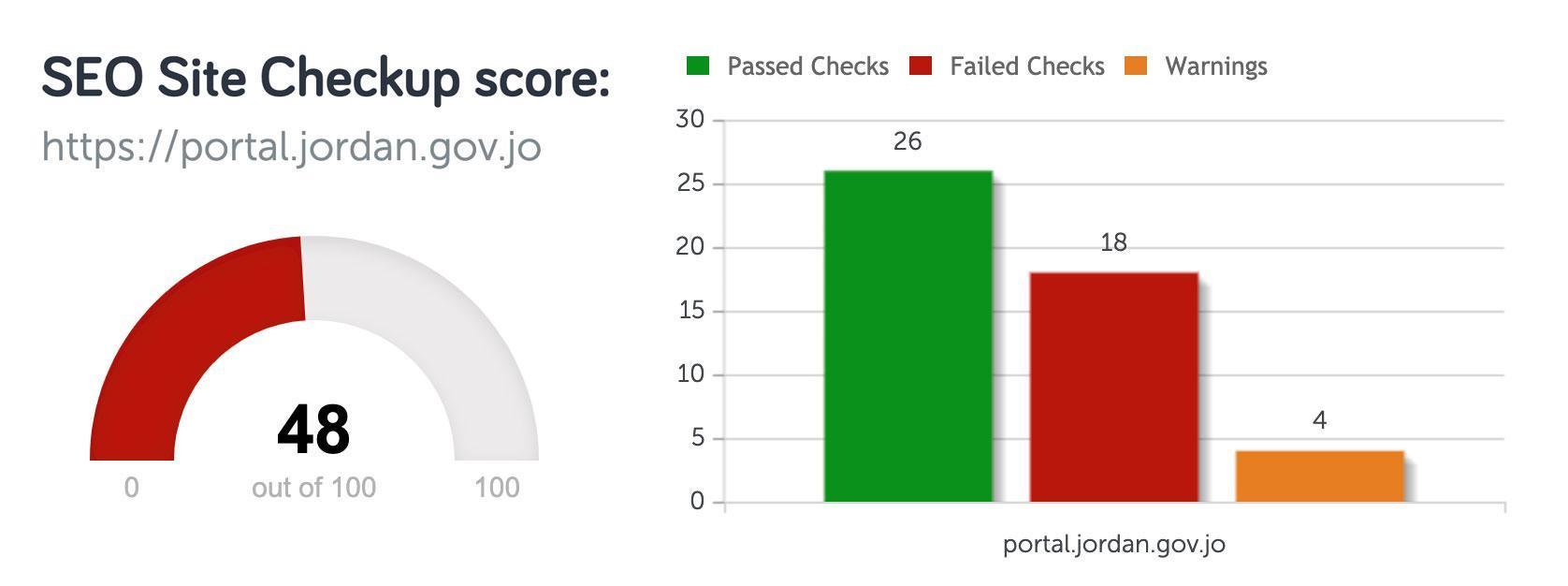
When a website has great UX design, customers may not even notice it. Its design is intuitive and has clear navigation and concise direction, allowing your visitor to go exactly where they need to. In addition, the task that leads to your website’s goal (making a purchase, calling for a quote, etc) is clear and simple (Horvath, 2019). In this paper we consulted a UX expert; (Mr. Abdulhameid Grandoka; https://abdulhameid.com/) to have an overall assessment about the US performance of Jordan’s E-government portal, his judgment was based on personal observation he assured that only 40% of the UX approach is implemented correctly.
One of the most important objectives for E-government is to provide quality service for stakeholders, this quality will be magnified by sharing the required information by all parties, hence, it is vital to provide information rich E-government portals to the end users. Jordanian E-government portal is performing very well in this aspect, out of total 120 government entities, 84 are already connected to the Secure Government Network (SGN), all the services provided by these entities are well explained on designated website in both native Arabic language and foreign English language, all procedures and prerequisites of any service is mentioned in detail, application forms available for download and printing, furthermore, 22 government entities are connected to the National Contact Centre (NCC) for more help and support.
Integrating governmental services into the E-government portal is the ultimate goal of the E-transformation process, it is what E-government all about, the number of provided services online would give an indication of success for the Egovernment efforts. For Jordanian E-government portal, there are 275 e-services integrated into the SGN which only four of them are transactional and only three of those services offer online payment.
From the literature review conducted using a qualitative methodology by conducting observations, automated tests and interviews with experts, we reached a number of findings that points to the problem of this research; the low EGDI of Jordan.
The government should allocate more resources to bridge the digital divide by enhancing the ICT infrastructure with more focus on the fiber-optic technology to boost the number of internet users in Jordan and provide more reliable and fast connectivity. Offering tax exemptions for telecom companies on expanding the area of broadband coverage would be another way to increase internet penetration by providing affordable accessibility to the internet for less fortunate suburban areas. Lowering the sales tax rate on mobile credit top-up would also increase the number of active mobile broadband subscribers. All these solutions will work in parallel to increase the TII ranking for Jordan.
ISSN 2348-1196 (print)
International Journal of Computer Science and Information Technology Research ISSN 2348-120X (online) Vol. 9, Issue 1, pp: (10-18), Month: January - March 2021, Available at: www.researchpublish.com
Despite the very high rate of literacy in Jordan, it does not have a significant positive impact on the technological savviness of the literate people, having HCI ranking just below the average reveals the problem in this criteria. The ministry of education should work effectively to conjugate the use of e-services in the public schools curriculum and place more oversight on the private ones to follow this change, starting from secondary level as the tertiary level has low rate with only 37.7% gross enrolment. Introduction vocational courses to enhance the technical skills of the fresh graduates for both public and private schools will also contribute towards strengthening the technical education in overall. Finally, People usually tend to resist the change, so policy makers should drive people to use the e-services by reducing smoothly the availability of former offline services.
Since OSI score is the lowest of the three indicators, the Jordan government should put the mission of improving it at utmost priority. From a technical perspective, a lot of work should be done on the e-government portal and other entities websites, the IT department responsible for developing the e-government websites should give their staff a dense training to gain technical skills required to solve the responsiveness, speed and SEO issues, a lot of free tools (such as used in this research) could be utilized to help the team achieving their goals.. A UX agency could be hired as a consultant to give a thorough analysis and plan to be carried out to change the whole UX of the e-government portal and websites. Finally, a survey should be conducted on the governmental services to make a list of top services used by citizens and businesses, then take effective actions to integrate these services into the e-government portals.
Given the difficult economic circumstances of Jordan, it is remarkable how it managed to accomplish notable achievements in the process of implementing e-government. The progression in the e-government strategy is essential in the whole country’s development. However, the regressing EGDI ranking in the last 10 years rang a bell in the policymaker rooms, the strategy looks perfect on paper, nevertheless, the on field actions are not reflecting the brightness of the plan. The practical actions of applying this strategy need to be rectified, improved or even changed. In this paper we tried to be closer to the field rather than top management, to give a crystal clear picture about the workflow to discover the flaws and shortcomings. The recommendations suggested by this research is very low level in the management hierarchy, thus, the team leaders in the field could be the targeted audience by this research findings and contribution. The policy makers should take the responsibility to assure that the implementation of their strategy matches the long term objectives of the original plan, keep monitoring it to catch any implications positive or negative, analyse it and revamp it whenever it's necessary.
[1] “E-government”, Retrieved from: https://en.wikipedia.org/wiki/E-government
[2] Department of Economic and Social Affairs, UN. (2020). UNITED NATIONS E-GOVERNMENT SURVEY 2020. Retrieved from: https://publicadministration.un.org/egovkb/en-us/Reports/UN-E-Government-Survey-2020
[3] "E-Participation Index", Retrieved from: https://publicadministration.un.org/egovkb/en-us/About/Overview/EParticipation-Index
[4] Grönlund, Åke & Horan, Thomas. (2004). “Introducing e-Gov: History, Definitions, and Issues”. Communications of the Association for Information Systems. Vol. 15, pp. 713-729.
[5] Jordan e-Government Program. (2013). “e-Government Strategy 2014-2016”. Retrieved from: https://portal. jordan.gov.jo/wps/wcm/connect/56d75661-abb5-4ecb-8826-67a1c3ee30df/e-Government_StrategyJO_Draft. pdf?MOD=AJPERES
[6] "E-Government in Jordan: A Guide for Policy-Makers". The Jordan Strategy Forum (JSF). Jul 2019.
[7] Alkhaffaf, Maha. (2018). “E-Government Readiness In Jordan: A Situation Analysis”. Al-Mithqal Journal of Economic and Management Sciences. 259.
ISSN 2348-1196 (print)
International Journal of Computer Science and Information Technology Research ISSN 2348-120X (online) Vol. 9, Issue 1, pp: (10-18), Month: January - March 2021, Available at: www.researchpublish.com
[8] Al-Jamal, M. & Abu-Shanab, E. (2016). "The influence of open government on e-government websites: the case of Jordan". Int. J. Electronic Governance, Vol. 8, No. 2, pp. 159-179.
[9] Majdalawi, Y., Almarabeh, T., Mohammad, H. & Qutechate, W. (2015). “E-Government Strategy and Plans in Jordan”. Journal of Software Engineering and Applications, Vol. 8, pp. 211-223.
[10] Ottoum, Issa S. I., (2015). "Launching E-Government in Jordan". World of Computer Science and Information Technology Journal (WCSIT), Vol. 5, No. 4, pp. 61-68.
[11] Samaha, Ala & Abdel Samad, Yara. (2014). "Challenges to the Jordanian Electronic Government Initiative". Journal of Business Systems, Governance and Ethics, Vol. 2, No. 3, pp. 101-109.
[12] Almarabeh, T. & Adwan, O. (2013). "A Detailed Study of E-government Readiness in Jordan". IJCSI International Journal of Computer Science Issues, Vol. 10, Issue 6, No 1, pp. 88-96.
[13] Kanaan, Raed & Kanan, Ghassan. (2013). “The Failure of E-government in Jordan to Fulfill Potential”. International Journal of Advanced Computer Science and Applications. Vol. 4, No. 12, pp. 157-161.
[14] Odat, A. & Khazaaleh, M.. (2012). “E-government challenges and opportunities: A case study of Jordan''. International Journal Of Computer Science Issues (IJCSI). Vol. 9. pp. 361-367.
[15] Khasawneh, Sahar. Jalghoum, Yase. Harfoushi, Osama. & Obiedat, Ruba. (2011). "E-Government Program in Jordan: From Inception to Future Plans". IJCSI International Journal of Computer Science Issues, Vol. 8, Issue 4, No 1, pp. 568-582.
[16] Suleiman, Rose E. S. & Ottoum, Issa S. I. (2011). "E-Government – The Jordanian Experience". ICIT 2011 The 5th International Conference on Information Technology.
[17] Obeidat, Rand & Abu-Shanab, Emad. (2010). “Drivers of E-Government and E-Business in Jordan”. Journal of Emerging Technologies in Web Intelligence. 2.
[18] Mohammad, Hiba & Almarabeh, Tamara & Ali, Amer. (2009). “E-government in Jordan”. European Journal of Scientific Research, Vol.35, No.2, pp.188-197.
[19] Abu Shanab, E. & Al-Radaideh, Q. (2009). "Jordan's E-Government Program: A User Centered Approach". ABHATH AL-YARMOUK: Basic Sci. & Eng., Vol. 18, No.1, pp. 63-74.
[20] Al-Hussein, Hussein. (2006). “E-Government Architecture In Jordan: A Comparative Analysis”. Journal of Computer Science. Vol. 2, No. 11, pp. 846-852.
[21] UNDP. (2018). “Human Development Indices and Indicators: 2018 Statistical Update: Jordan”. Retrieved from: http://hdr.undp.org/sites/default/files/Country-Profiles/JOR.pdf
[22] “What Makes A Professional Website – 6 Parameters”. Retrieved from: https://w3-lab.com/professional-websiteparameters/
[23] Christo Petrov. (2020). “57 Mobile vs. Desktop Usage Statistics For 2020 [Mobile’s Overtaking!]”. Retrieved from: https://techjury.net/blog/mobile-vs-desktop-usage
[24] Richard Horvath. (2019). "Why is UX Design Essential to Your Website?". Retrieved from: https://www.theedigital com/blog/ux-design-website